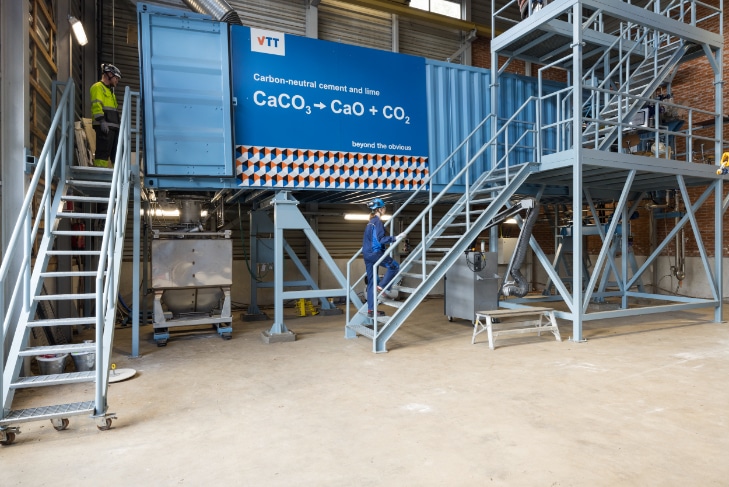New Tech Suggests Drop in Cement Emissions
BY VTT

Together with its business partners, VTT Technical Research Centre of Finland Ltd. has developed a solution designed to bring a reduction in carbon dioxide emissions in the production of cement and quicklime. As one of the ingredients for concrete, cement is the world’s most used building material and is responsible for around 7% of the world’s carbon dioxide emissions. By using low-emission electricity instead of combustion for decomposing calcium carbonate—a central part of cement production—and by capturing the carbon dioxide produced in the production process, it is possible to run a cement plant with close to zero carbon dioxide emissions. This is made possible by using a gas-tight, electrically-heated rotary kiln.
The main raw material for cement is limestone. Quicklime is also required in huge quantities in the pulp and steel industries. In the production of cement and quicklime, emissions are generated for two reasons. At present, the production takes place at temperatures above 1,832 degrees F (1,000°C), and this releases emissions into the atmosphere.
An even bigger problem for the climate, however, is the carbonate contained in limestone, which decomposes in the production process into carbon dioxide and quicklime. These emissions that result from the raw material itself cannot be avoided without replacing limestone, one of the world’s most used raw materials.
“Replacing combustion processes with electricity-based solutions and significantly increasing emission-free electricity production is an effective means of curbing climate change,” explained Project Manager Eemeli Tsupari, principal scientist at VTT. “With this technology, the pure carbon dioxide from the limestone can be captured and then either stored or utilized in, for example, the manufacture of low-emission products. There is already a market for carbon dioxide as a gas used in the production process, and a number of potential uses are being developed that would massively increase the scale of its use.”
Emissions trading guides EU-wide emission reductions
The Decarbonate project, led by VTT, involved constructing a 39-foot, 4-inch (12-meter) electrically-heated rotary kiln, which was then used to test out, together with VTT’s business partners, the precalcination of the raw powder for cement and the production of both quicklime and also the lime mud used in pulp mills. The project involves key Finnish players in the sector, including Finnsementti, Nordkalk and UPM. The test kiln could also be used for reducing emissions in other industrial sectors, such as the battery and asphalt industries.
“Finnsementti has been working on climate change for a long time, and several emission reduction projects are under way,” explained Ulla Leveelahti, environmental manager at Finnsementti. “Minimizing fossil energy use and utilizing carbon capture will be an integral part of the future of the cement industry.”

At present, the production of quicklime takes place at temperatures above 1,832 degrees F, and this releases emissions into the atmosphere.
In the EU, emissions trading is steering the industry towards reducing emissions. At the current price level, a decrease of one tonne in carbon dioxide emissions means a savings of EUR 60 for the company. For a medium-sized cement plant, for example, a one-third reduction in emissions would mean savings of several million euros per year. In addition, the electric kiln produces a new product: purified carbon dioxide. In other words, electrically-powered calcination could be economically viable already at current prices, but assessing its feasibility at the industrial scale and the investments required for this will require further studies.
Industry Incorporates Sustainability at Asphalt Production Plants – Part II
